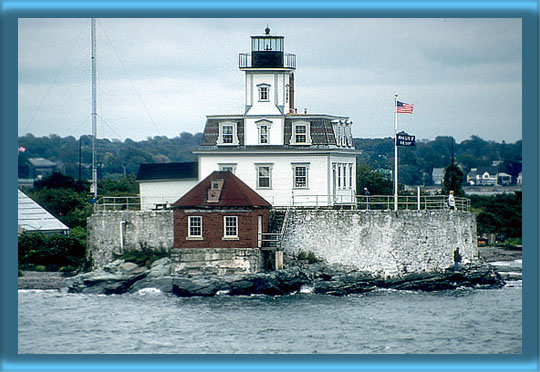Rose Island Lighthouse's second keeper George Williams died in on January 7, 1879. There was a common practice at the time for the keeper's widow to replace him if she wanted to. People didn't want her as the keeper. An article in January 9, 1879 edition of the Boston Post stated that "An effort is being made in Newport to defeat the appointment of the widow of the late keeper of Rose Island Lighthouse to the vacancy occasioned by his death." There were a dozen applicants for the position in just two days. There was an effort by Newport's leading citizen to help her get the job. It failed. Charles F. Williams was appointed as the new keeper on February 9, 1879.
A mechanical fog bell was established at Rose Island Lighthouse on August 10, 1885. It worked like a clock. The keeper would wind it and it would ring the bell until it ran down. The fog bell was in a wooden tower next to the lighthouse. The fog bell rang twice every fifteen seconds.
On April 21, 1894 Rose Lighthouse's fourth Keeper Charles S. Curtis' son made a horrible discovery. He found grave robbers taking two bodies from graves on the island. The grave robbers escaped in a boat and disappeared into the fog.
In the first two weeks of February 1899 the United States was hit by some of the coldest winter weather in its history. Temperatures in the northeast United States dropped to 5 and 10 degrees below zero for over a week. A blizzard hit Newport on February 10 and lasted two days. Parts of Newport harbor froze over during the storm, trapping keeper Curtis and his family on Rose Island. He couldn't get food or coal to heat the lighthouse. Some of his family members got sick and needed help.
On February 14, Curtis climbed to the top of the lighthouse's flag pole and turned the American flag upside down as a distress signal. The officers on the United States Revenue Service cutter Dexter noticed the signal and went to his aid. The cutter had to break through sheets of ice to get to Rose Island Lighthouse. When they reached the lighthouse, they found out that some of Curtis's family was sick and that there was very little food or fuel at the lighthouse. The Dexter took the sick people to the nearby Goat Island torpedo station and brought food and coal to the lighthouse.
| United States Revenue Cutter Service cutter USRC Dexter (1874) |
|---|
.jpg) |
| By U.S. Coast Guard Historian's Office Photo |
James Crockett was fishing off Rose Island on January 30, 1901, when a snowstorm started. His boat went aground on the reef on the north end of Rose Island at 5 o'clock in the evening. He stayed with the boat for several hours until the storm worsened.
At 10 o'clock that night he decided he had to get to Rose Island. There were two wooden fish storage boxes on the boat. He put one of the boxes into the water and rowed to the north end of the island. He reached the island and went to the lighthouse. Curtis took Crockett to Newport in the morning. Crockett's boat was washed off the reef and was found floating off Castle Hill.
In the early twentieth century Navy ships had to moor in Newport Harbor. The sailors on the ships had to a take a launch, a ship's motorboat, from ship to shore and back. On August 5, 1906 a launch containing officers from the USS Maine and Jamestown residents were returning to the Maine, when it got stuck on rocks near Rose Island. Keeper Curtis went to their aid. He took the Jamestown residents back to Jamestown and the officers back to the Maine.
On October 31, 1906 keeper Charles Curtis noticed a small fishing boat floundering off Rose Island. A wind gust flipped the boat over. The fisherman in the boat was thrown into the water. Curtis went out to the fisherman and pulled him out of the water. He took him back to the lighthouse and kept him overnight at the lighthouse.
In 1912 Rose Island lighthouse was enlarged and the second floor was remodeled for an assistant keeper. Rose Island Lighthouse's first assistant keeper Julius Johnanssen reported for duty on November 12. He stayed at Rose Island until 1915, when he was replaced by Charles Fletcher.
In 1918 congress passed a bill that gave long term and old lighthouse service employees a pension. They would receive a minimum of one fortieth of their annual pay. It also made retirement mandatory at seventy. Keeper Charles Curtis was forced to retire because he was over seventy. He was placed on the retirement list on January 30, 1919. He was replaced by Thomas Pickup.
In the era before radar, sonar and GPS, submerged rocks and a shoal around Rose Island made traveling near the island hazardous, even with the lighthouse. From the 1890s to the 1920s at least seven large ships ran aground near the island. Most of the grounding occurred at low speed, so the ships weren't badly damaged
For a time there were two lights on Rose Island. The Navy used the island to store torpedoes and explosives on the island. A revolving red light was placed on the island in July 1933 to warn airplanes where explosives were stored. It was removed when the Navy stopped using the island in the 1950s.
On August 7, 1958, the lighthouse was nearly lost when two tankers, the Gulfoil and the S.E. Graham, collided in dense fog near Fort Adams. The ships exploded into flames. The Graham, her engines dead, was pushed into Newport Harbor by the tide. The burning tanker drifted to within 200 feet of the Rose Island Lighthouse. It was so close that the lighthouse's walls became hot. The keepers, Theodore Bank and Robert Flynn, had to leave the lighthouse. The tide and wind moved the Graham away from Rose Island and saved the light. Between the two ships eighteen men were killed.
| Graham Burning Near Rose Island Lighthouse in 1958 |
|---|
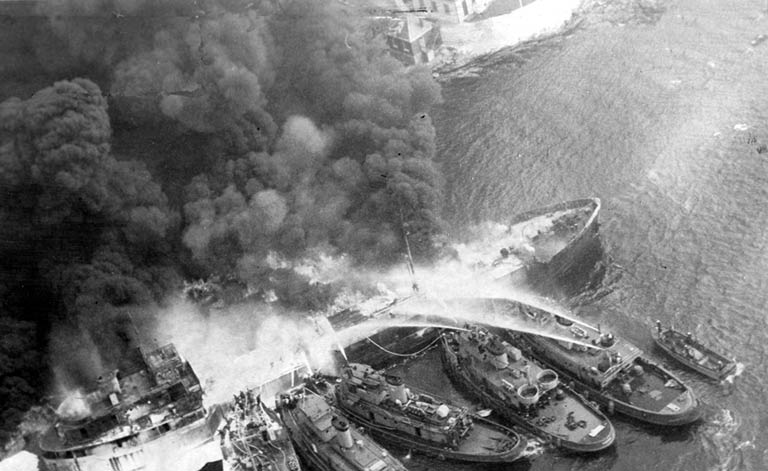 |
| Collection of R. Holmes |
In 1969 the Newport Bridge was finished. It also finished Rose Island light. The Coast Guard closed the lighthouse in 1971. The University of Rhode Island used it as a marine research facility for a short time. With no one to watch over it, the lighthouse was vandalized and left to decay. It was declared surplus by the government in 1984. The city of Newport acquired the lighthouse and the land around it.
The Rose Island Lighthouse Foundation was formed in 1984 to in restore and maintain the lighthouse. After years of hard work the light was relighted in 1993 as a private aid to navigation. To raise money to maintain the lighthouse the foundation started a guest keeper program. Visitors pay to stay at the lighthouse overnight or for a week. Rates vary depending on the length of your stay. There are five rooms, the Curt Bunting Room, the Wanton Chase Room, the Keeper's Apartment, the Foghorn Room and the Barracks Room available at the lighthouse.
On June 25, 1999 the Rose Island Lighthouse Foundation acquired the rest of the island. The whole island will now be protected.
On August 12, 2013 a reproduction of a sixth-order Fresnel lens and pedestal was installed in the lantern room at Rose Island Lighthouse. It was built by Artworks Florida; the company restores historic Fresnel lenses and makes custom reproductions of Fresnel lenses. The lens cost $30,000; this includes the pedestal, lens, lamp and installation. It took six months to build the lens.
| Rose Island Fresnel Lens - 2013 |
|---|
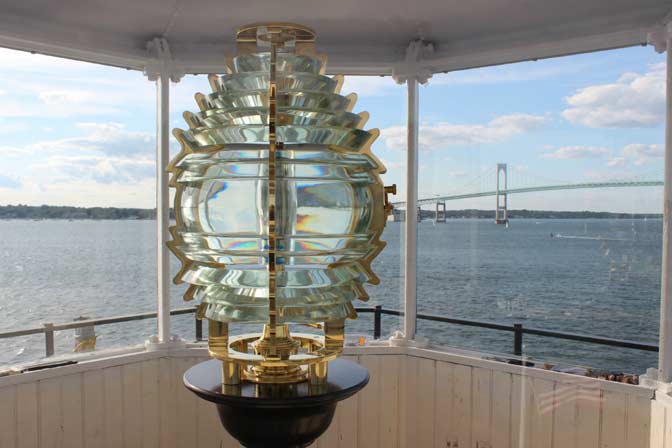 |
| Courtesy of Dan Spinella and Artworks Florida |
| Interior of Rose Island Fresnel Lens - 2013 |
|---|
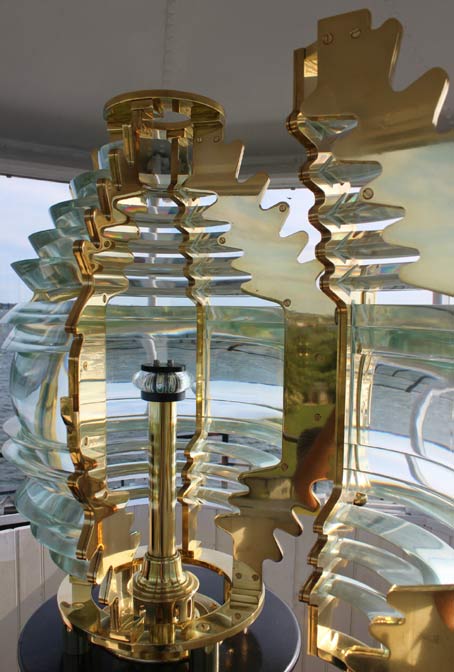 |
| Courtesy of Dan Spinella and Artworks Florida |
See more of Rose Island Lighthouse in Rhode Island Lighthouses: A Pictorial History by R Holmes.
| Rose Island Lighthouse in 1900 |
|---|
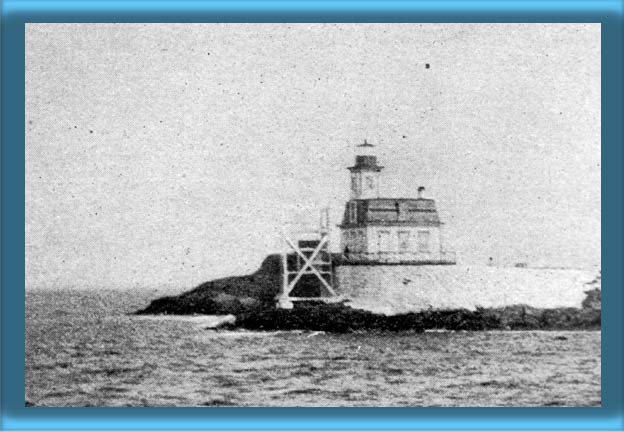 |
| Courtesy of N.L. Stebbins |
For information
on the Rose Island Lighthouse Foundation, contact:
Rose Island Lighthouse Foundation
P.O. Box 1419
Newport, RI 02840
Rose Island Lighthouse Foundation
P.O. Box 1419
Newport, RI 02840
